HYUNDAI COUPE 2014 Owner's Manual
Manufacturer: HYUNDAI, Model Year: 2014, Model line: COUPE, Model: HYUNDAI COUPE 2014Pages: 546, PDF Size: 14.38 MB
Page 21 of 546
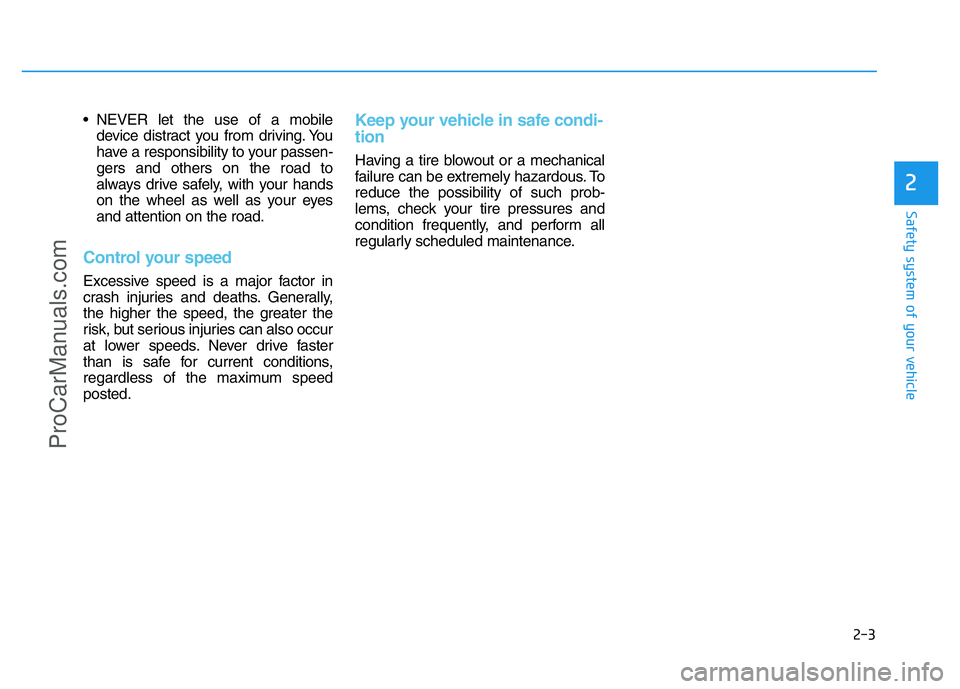
2-3
Safety system of your vehicle
• NEVER let the use of a mobile
device distract you from driving. You
have a responsibility to your passen-
gers and others on the road to
always drive safely, with your hands
on the wheel as well as your eyes
and attention on the road.
Control your speed
Excessive speed is a major factor in
crash injuries and deaths. Generally,
the higher the speed, the greater the
risk, but serious injuries can also occur
at lower speeds. Never drive faster
than is safe for current conditions,
regardless of the maximum speed
posted.
Keep your vehicle in safe condi-
tion
Having a tire blowout or a mechanical
failure can be extremely hazardous. To
reduce the possibility of such prob-
lems, check your tire pressures and
condition frequently, and perform all
regularly scheduled maintenance.
2
ProCarManuals.com
Page 22 of 546
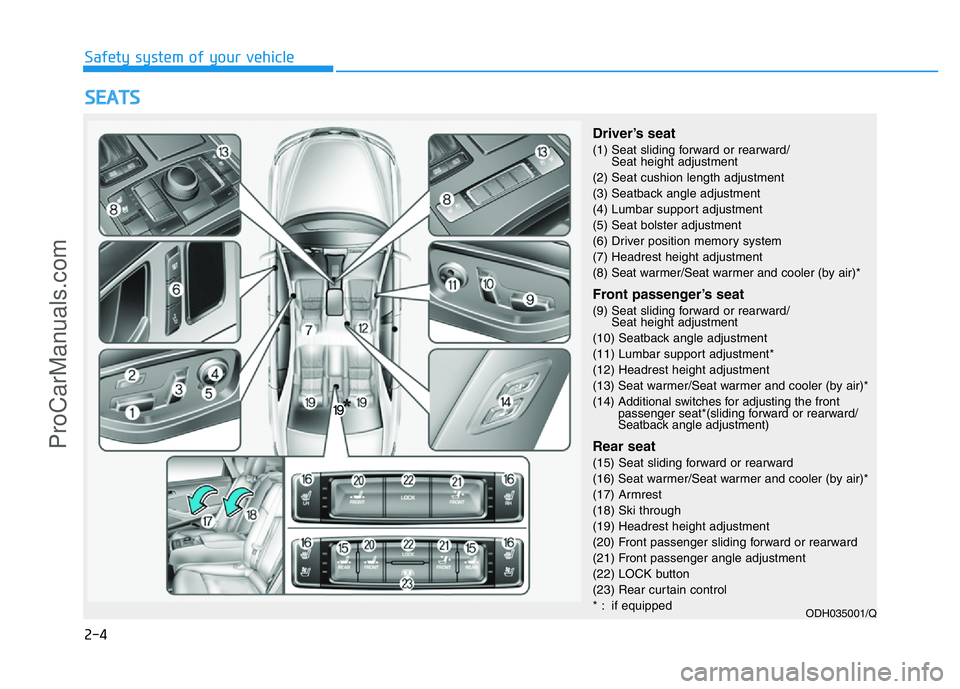
2-4
SEATS
Safety system of your vehicle
Driver’s seat
(1) Seat sliding forward or rearward/
Seat height adjustment
(2) Seat cushion length adjustment
(3) Seatback angle adjustment
(4) Lumbar support adjustment
(5) Seat bolster adjustment
(6) Driver position memory system
(7) Headrest height adjustment
(8) Seat warmer/Seat warmer and cooler (by air)*
Front passenger’s seat
(9) Seat sliding forward or rearward/
Seat height adjustment
(10) Seatback angle adjustment
(11) Lumbar support adjustment*
(12) Headrest height adjustment
(13) Seat warmer/Seat warmer and cooler (by air)*
(14) Additional switches for adjusting the front
passenger seat*(sliding forward or rearward/
Seatback angle adjustment)
Rear seat
(15) Seat sliding forward or rearward
(16) Seat warmer/Seat warmer and cooler (by air)*
(17) Armrest
(18) Ski through
(19) Headrest height adjustment
(20) Front passenger sliding forward or rearward
(21) Front passenger angle adjustment
(22) LOCK button
(23) Rear curtain control
* : if equipped
ODH035001/Q
* *
ProCarManualsйcom
Page 23 of 546
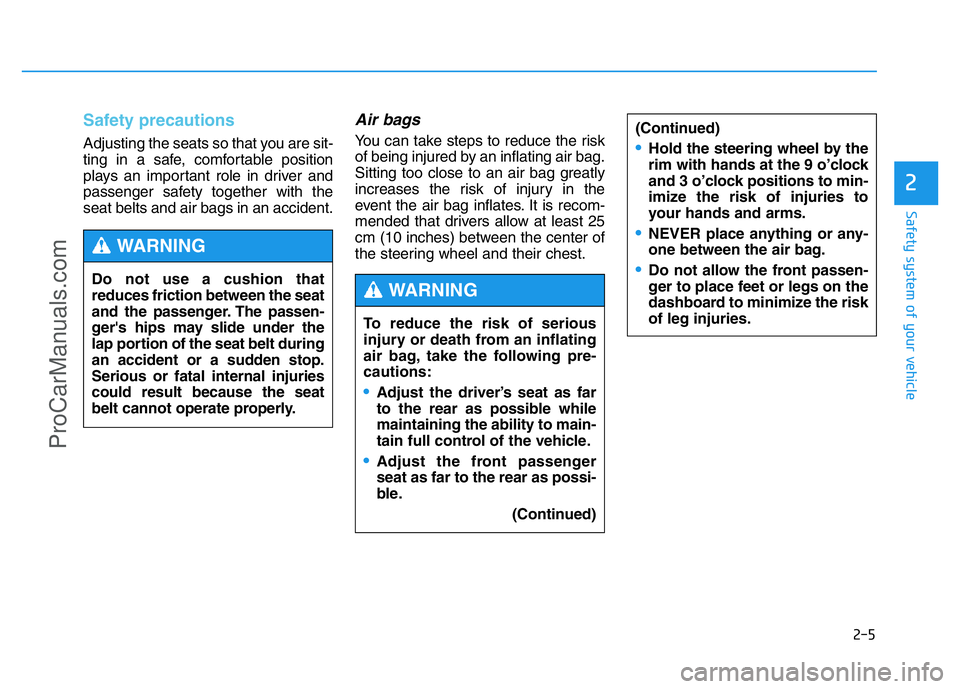
To reduce the risk of serious
injury or death from an inflating
air bag, take the following pre-
cautions:
•Adjust the driver’s seat as far
to the rear as possible while
maintaining the ability to main-
tain full control of the vehicle.
•Adjust the front passenger
seat as far to the rear as possi-
ble.
(Continued)
WARNING
(Continued)
•Hold the steering wheel by the
rim with hands at the 9 o’clock
and 3 o’clock positions to min-
imize the risk of injuries to
your hands and arms.
•NEVER place anything or any-
one between the air bag.
•Do not allow the front passen-
ger to place feet or legs on the
dashboard to minimize the risk
of leg injuries.
2-5
Safety system of your vehicle
2
Safety precautions
Adjusting the seats so that you are sit-
ting in a safe, comfortable position
plays an important role in driver and
passenger safety together with the
seat belts and air bags in an accident.
Air bags
You can take steps to reduce the risk
of being injured by an inflating air bag.
Sitting too close to an air bag greatly
increases the risk of injury in the
event the air bag inflates. It is recom-
mended that drivers allow at least 25
cm (10 inches) between the center of
the steering wheel and their chest.
Do not use a cushion that
reduces friction between the seat
and the passenger. The passen-
ger's hips may slide under the
lap portion of the seat belt during
an accident or a sudden stop.
Serious or fatal internal injuries
could result because the seat
belt cannot operate properly.
WARNING
ProCarManuals.com
Page 24 of 546

2-6
Safety system of your vehicle
Seat belts
Always fasten your seat belt before
starting any trip.
At all times, passengers should sit
upright and be properly restrained.
Infants and small children must be
restrained in appropriate child restraint
systems. Children who have outgrown
a booster seat and adults must be
restrained using the seat belts.
Front seats
The front seat can be adjusted by
using the control switches located on
the outside of the seat cushion. Before
driving, adjust the seat to the proper
position so that you can easily control
the steering wheel, foot pedals and
controls on the instrument panel.
Take the following precautions
when adjusting your seat belt:
•NEVER use one seat belt for
more than one occupant.
•Always position the seatback
upright with the lap portion of
the seat belt snug and low
across the hips.
•NEVER allow children or small
infants to ride in a passenger’s
lap.
(Continued)
(Continued)
•Do not route the seat belt
across your neck, across sharp
edges, or reroute the shoulder
strap away from your body.
•Do not allow the seat belt to
become caught or jammed.
WARNING Take the following precautions
when adjusting your seat:
•NEVER attempt to adjust the
seat while the vehicle is mov-
ing. The seat could respond
with unexpected movement
and may cause loss of vehicle
control resulting in an acci-
dent.
•Do not place anything under
the front seats. Loose objects
in the driver’s foot area could
interfere with the operation of
the foot pedals, causing an
accident.
(Continued)
WARNING
ProCarManuals.com
Page 25 of 546
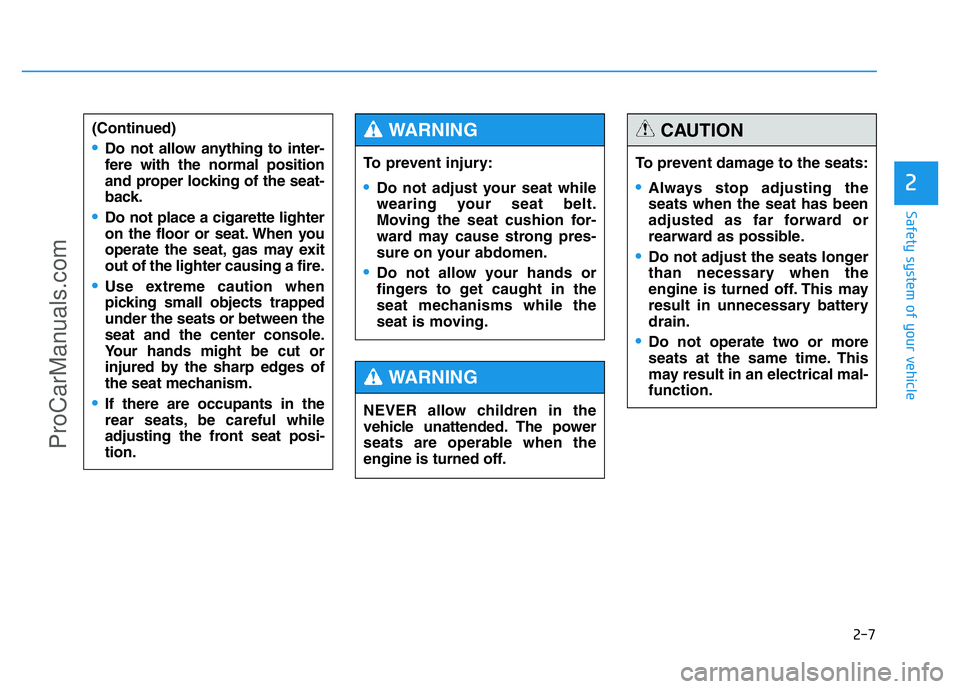
2-7
Safety system of your vehicle
2
To prevent injury:
•Do not adjust your seat while
wearing your seat belt.
Moving the seat cushion for-
ward may cause strong pres-
sure on your abdomen.
•Do not allow your hands or
fingers to get caught in the
seat mechanisms while the
seat is moving.
WARNING (Continued)
•Do not allow anything to inter-
fere with the normal position
and proper locking of the seat-
back.
•Do not place a cigarette lighter
on the floor or seat. When you
operate the seat, gas may exit
out of the lighter causing a fire.
•Use extreme caution when
picking small objects trapped
under the seats or between the
seat and the center console.
Your hands might be cut or
injured by the sharp edges of
the seat mechanism.
•If there are occupants in the
rear seats, be careful while
adjusting the front seat posi-
tion.
To prevent damage to the seats:
•Always stop adjusting the
seats when the seat has been
adjusted as far forward or
rearward as possible.
•Do not adjust the seats longer
than necessary when the
engine is turned off. This may
result in unnecessary battery
drain.
•Do not operate two or more
seats at the same time. This
may result in an electrical mal-
function.
CAUTION
NEVER allow children in the
vehicle unattended. The power
seats are operable when the
engine is turned off.
WARNING
ProCarManuals.com
Page 26 of 546
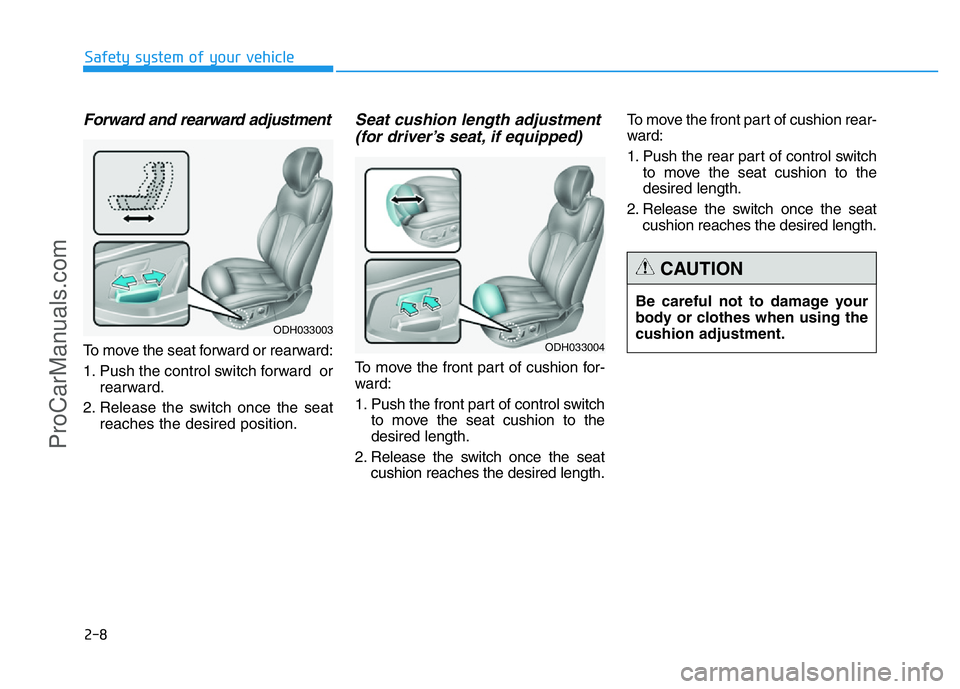
2-8
Safety system of your vehicle
Be careful not to damage your
body or clothes when using the
cushion adjustment.
CAUTION
Forward and rearward adjustment
To move the seat forward or rearward:
1. Push the control switch forward or
rearward.
2. Release the switch once the seat
reaches the desired position.
Seat cushion length adjustment
(for driver’s seat, if equipped)
To move the front part of cushion for-
ward:
1. Push the front part of control switch
to move the seat cushion to the
desired length.
2. Release the switch once the seat
cushion reaches the desired length.To move the front part of cushion rear-
ward:
1. Push the rear part of control switch
to move the seat cushion to the
desired length.
2. Release the switch once the seat
cushion reaches the desired length.
ODH033003
ODH033004
ProCarManuals.com
Page 27 of 546
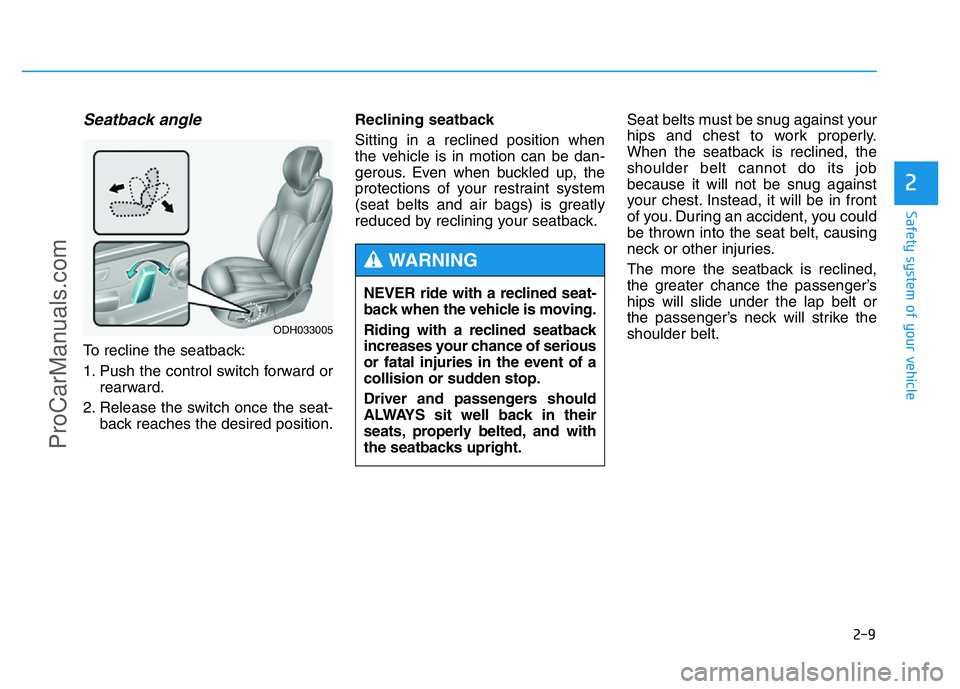
2-9
Safety system of your vehicle
2
Seatback angle
To recline the seatback:
1. Push the control switch forward or
rearward.
2. Release the switch once the seat-
back reaches the desired position.Reclining seatback
Sitting in a reclined position when
the vehicle is in motion can be dan-
gerous. Even when buckled up, the
protections of your restraint system
(seat belts and air bags) is greatly
reduced by reclining your seatback.Seat belts must be snug against your
hips and chest to work properly.
When the seatback is reclined, the
shoulder belt cannot do its job
because it will not be snug against
your chest. Instead, it will be in front
of you. During an accident, you could
be thrown into the seat belt, causing
neck or other injuries.
The more the seatback is reclined,
the greater chance the passenger’s
hips will slide under the lap belt or
the passenger’s neck will strike the
shoulder belt.
ODH033005
NEVER ride with a reclined seat-
back when the vehicle is moving.
Riding with a reclined seatback
increases your chance of serious
or fatal injuries in the event of a
collision or sudden stop.
Driver and passengers should
ALWAYS sit well back in their
seats, properly belted, and with
the seatbacks upright.
WARNING
ProCarManuals.com
Page 28 of 546
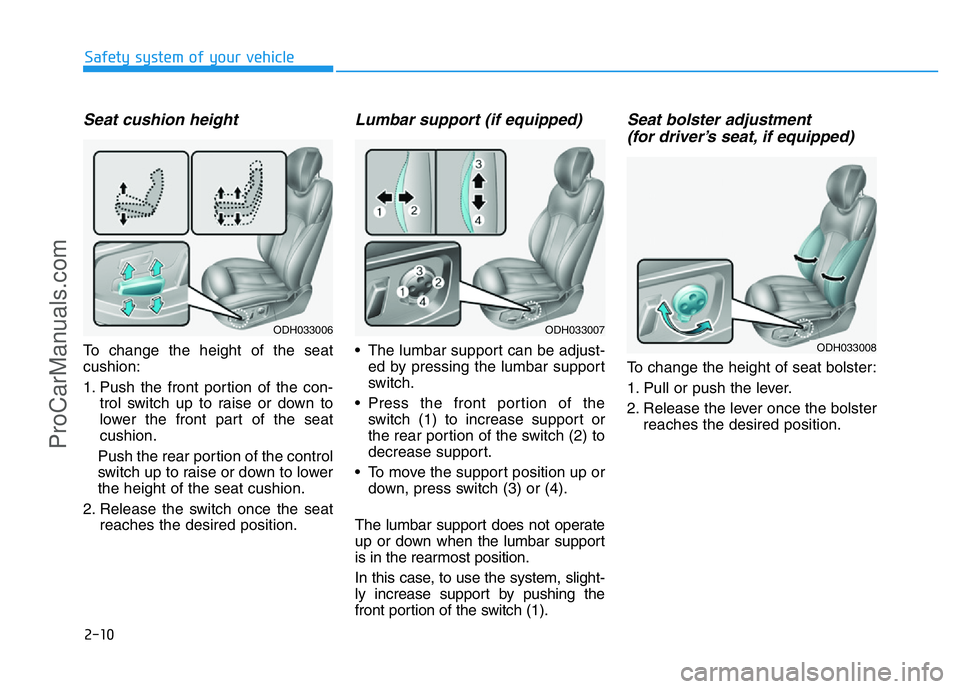
2-10
Safety system of your vehicle
Seat cushion height
To change the height of the seat
cushion:
1. Push the front portion of the con-
trol switch up to raise or down to
lower the front part of the seat
cushion.
Push the rear portion of the control
switch up to raise or down to lower
the height of the seat cushion.
2. Release the switch once the seat
reaches the desired position.
Lumbar support (if equipped)
• The lumbar support can be adjust-
ed by pressing the lumbar support
switch.
• Press the front portion of the
switch (1) to increase support or
the rear portion of the switch (2) to
decrease support.
• To move the support position up or
down, press switch (3) or (4).
The lumbar support does not operate
up or down when the lumbar support
is in the rearmost position.
In this case, to use the system, slight-
ly increase support by pushing the
front portion of the switch (1).
Seat bolster adjustment
(for driver’s seat, if equipped)
To change the height of seat bolster:
1. Pull or push the lever.
2. Release the lever once the bolster
reaches the desired position.
ODH033006ODH033007
ODH033008
ProCarManuals.com
Page 29 of 546
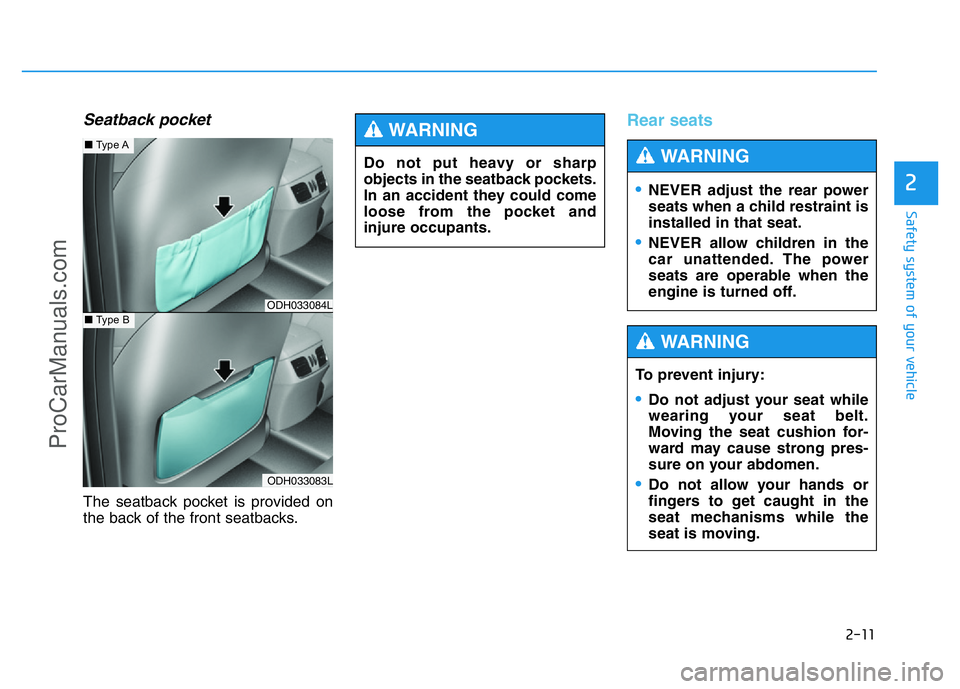
2-11
Safety system of your vehicle
2
Seatback pocket
The seatback pocket is provided on
the back of the front seatbacks.
Rear seats
Do not put heavy or sharp
objects in the seatback pockets.
In an accident they could come
loose from the pocket and
injure occupants.
WARNING
•NEVER adjust the rear power
seats when a child restraint is
installed in that seat.
•NEVER allow children in the
car unattended. The power
seats are operable when the
engine is turned off.
WARNING
To prevent injury:
•Do not adjust your seat while
wearing your seat belt.
Moving the seat cushion for-
ward may cause strong pres-
sure on your abdomen.
•Do not allow your hands or
fingers to get caught in the
seat mechanisms while the
seat is moving.
WARNING
ODH033084L
ODH033083L
■Type A
■Type B
ProCarManuals.com
Page 30 of 546
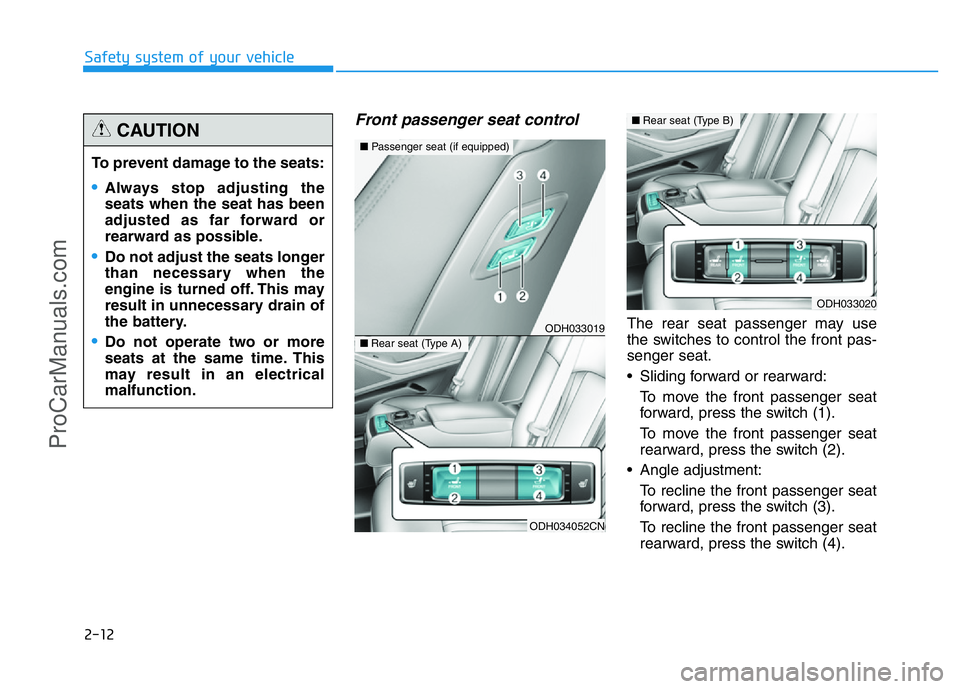
2-12
Safety system of your vehicle
Front passenger seat control
The rear seat passenger may use
the switches to control the front pas-
senger seat.
• Sliding forward or rearward:
To move the front passenger seat
forward, press the switch (1).
To move the front passenger seat
rearward, press the switch (2).
• Angle adjustment:
To recline the front passenger seat
forward, press the switch (3).
To recline the front passenger seat
rearward, press the switch (4).
ODH033020
ODH033019
ODH034052CN
■Passenger seat (if equipped)
■Rear seat (Type A)
■Rear seat (Type B)■Rear seat (Type B)
To prevent damage to the seats:
•Always stop adjusting the
seats when the seat has been
adjusted as far forward or
rearward as possible.
•Do not adjust the seats longer
than necessary when the
engine is turned off. This may
result in unnecessary drain of
the battery.
•Do not operate two or more
seats at the same time. This
may result in an electrical
malfunction.
CAUTION
ProCarManuals.com